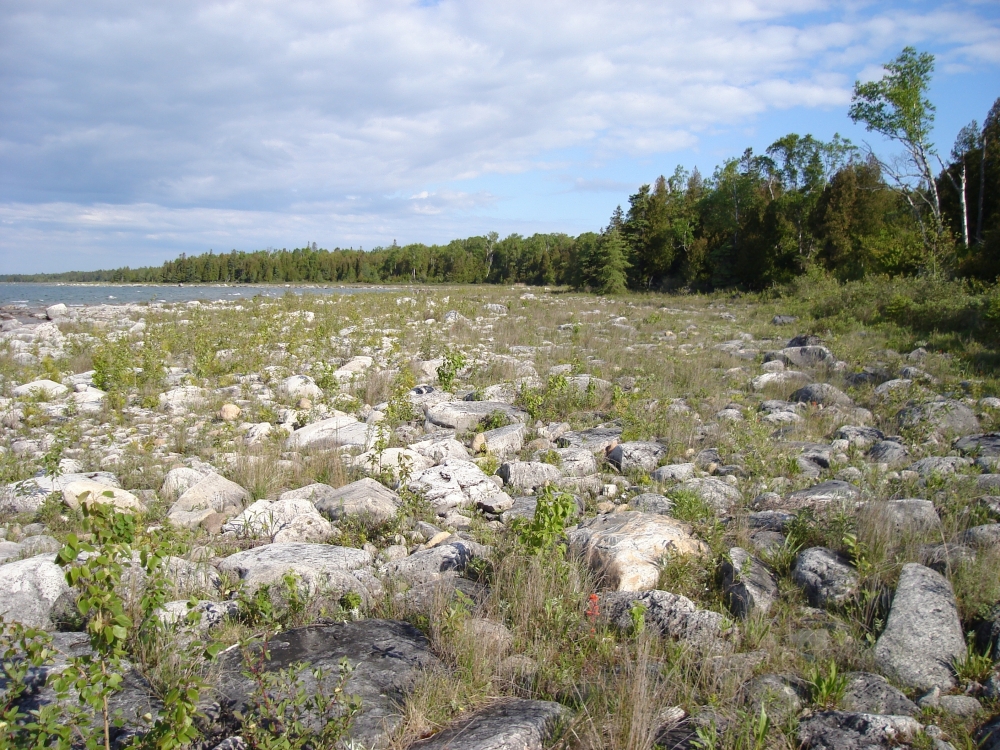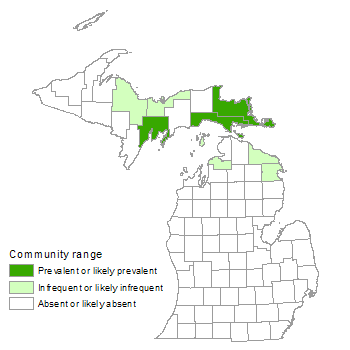Limestone Cobble Shore
Overview
Limestone cobble shore occurs along the northern Lake Michigan and Lake Huron shorelines. The community is typically sparsely vegetated, because cobbles cover most of the surface and storm waves prevent the development of a diverse, persistent plant community.
Rank
Global Rank: G2G3 - Rank is uncertain, ranging from imperiled to vulnerable
State Rank: S3 - Vulnerable

Landscape Context
Cobble shores are most extensive along the Niagaran Cuestra, a gentle bedrock plain that runs along the north shore of Lake Michigan, Lake Huron, and Georgian Bay, from the Door Peninsula in northern Wisconsin to the Bruce Peninsula of Ontario. Cobble shores are also common on many of the northern islands of all three of these large water bodies. Most of the cobbles were part of Silurian and Ordovician limestone reefs that formed in the shallow seas of the Michigan Basin. Farther south, in Presque Isle and Alpena counties in northern Lower Michigan, the marine deposits are Devonian-age limestones, which were also formed in shallow seas. Cobble shores often occur interspersed with limestone pavement and adjacent to coastal fen, Great Lakes marsh, boreal forest, limestone bedrock glade, and alvar grassland.
Soils
The size of the cobbles and both the depth and texture of underlying sediments vary greatly and can affect both the diversity and stability of the plant community. While most of the beach surface consists of cobbles of varying size, the underlying parent material is either limestone bedrock or fine-textured till. Between the cobbles there is rock, mineral, or organic soils. Soil texture is typically heavy clay or loam, but in some areas these fine-textured soils are overlain with a thin veneer of sand. Organic sediments can accumulate to 5 cm or more in protected inner portions of the shore. Regardless of the soil texture, pH is mildly to moderately alkaline. Deep accumulations of large cobbles tend to be quite dry and are nearly unvegetated. In contrast, shallow accumulations of small gravel and cobbles, especially when mixed with a moist sandy substrate, tend to support denser and more diverse plant cover.
Natural Processes
Cobble beaches are a dynamic environment of wind and waves. Storm waves regularly disturb the beaches, reconfiguring the substrate and removing fine sediments. During the winter, shoreline ice freezes to the bottom and is plucked loose during storms, further eroding and modifying the bottom. Intense winter storms can result in the formation of storm beaches, in which cobble-sized rocks are piled upon each other. Storm beaches can accumulate cobbles up to several meters or more in depth. Longer term, cyclic fluctuations of Great Lakes water levels significantly influence vegetation patterns of limestone cobble shores, with vegetation becoming well established during low-water periods and most species dying back or disappearing during high-water periods.
Vegetation
Among the frequently encountered plants are dwarf Canadian primrose (Primula mistassinica), harebell (Campanula rotundifolia), low calamint (Clinopodium arkansanum), bog lobelia (Lobelia kalmii), silverweed (Potentilla anserina), grass-of-Parnassus (Parnassia glauca), false asphodel (Triantha glutinosa), tickle-grass (Agrostis scabra), sedge (Carex viridula), rushes (Juncus balticus and J. dudleyi), gold-seeded spike-rush (Eleocharis elliptica), beak-rush (Rhynchospora capillacea), small fringed gentian (Gentianopsis virgata), Indian paintbrush (Castilleja coccinea), Ohio goldenrod (Solidago ohioensis), variegated scouring rush (Equisetum variegatum), common boneset (Eupatorium perfoliatum), white camas (Anticlea elegans), grass-leaved goldenrod (Euthamia graminifolia), slender bog arrow-grass (Triglochin palustris), Kalm’s St. John’s-wort (Hypericum kalmianum), and balsam poplar (Populus balsamifera).
Limestone cobble shore gradually grades from open, unvegetated cobbles closer to the water’s edge to a more vegetated herbaceous zone farther inland. Within the ground cover there are often shrub-sized balsam poplar, tamarack (Larix laricina), paper birch (Betula papyrifera), and northern white-cedar (Thuja occidentalis). Recurring high water does not allow these trees to reach maturity, but just inland of the open cobble shore is typically a dense thicket of upland trees and shrubs, including balsam poplar, tamarack, northern white-cedar, paper birch, quaking aspen (Populus tremuloides), and white spruce (Picea glauca), along with soapberry (Shepherdia canadensis), tag alder (Alnus incana), and shrubby cinquefoil (Dasiphora fruticosa).
Surveys of cobble shores have been few, but many of the species listed above are common plants of the calcium-rich shoreline of the northern Great Lakes. Many of the species characteristic of either the nearby bedrock shore, coastal fen, or northern fen communities can be found growing scattered along cobble shores, including many of the rare species.
For information about plant species, visit the Michigan Flora website.
Plant Lists
Graminoids
- ticklegrass (Agrostis scabra)
- narrow-leaved reedgrass (Calamagrostis stricta)
- sedges (Carex crawei, C. eburnea, and C. viridula)
- twig-rush (Cladium mariscoides)
- tufted hair grass (Deschampsia cespitosa)
- Lindheimer panic grass (Dichanthelium lindheimeri)
- golden-seeded spike-rush (Eleocharis elliptica)
- spike-rush (Eleocharis quinqueflora)
- beaked spike-rush (Eleocharis rostellata)
- rushes (Juncus balticus, J. brachycephalus, J. brevicaudatus, J. dudleyi, and J. nodosus)
- common reed (Phragmites australis subsp. americanus)
- beak-rush (Rhynchospora capillacea)
- hardstem bulrush (Schoenoplectus acutus)
- threesquare (Schoenoplectus pungens)
Forbs
- purple false foxglove (Agalinis purpurea)
- white camas (Anticlea elegans)
- wild columbine (Aquilegia canadensis)
- harebell (Campanula rotundifolia)
- Indian paintbrush (Castilleja coccinea)
- limestone calamint (Clinopodium arkansanum)
- common boneset (Eupatorium perfoliatum)
- grass-leaved goldenrod (Euthamia graminifolia)
- small fringed gentian (Gentianopsis virgata)
- Kalm’s lobelia (Lobelia kalmii)
- balsam ragwort (Packera paupercula)
- grass-of-Parnassus (Parnassia glauca)
- silverweed (Potentilla anserina)
- bird’s-eye primrose (Primula mistassinica)
- Houghton’s goldenrod (Solidago houghtonii )
- Ohio goldenrod (Solidago ohioensis)
- upland white goldenrod (Solidago ptarmicoides)
- bog goldenrod (Solidago uliginosa)
- panicled aster (Symphyotrichum lanceolatum)
- false asphodel (Triantha glutinosa)
- common bog arrow-grass (Triglochin maritima)
- slender bog arrow-grass (Triglochin palustris)
- broad-leaved cat-tail (Typha latifolia)
Fern Allies
- variegated scouring rush (Equisetum variegatum)
- selaginella (Selaginella eclipes)
Shrubs
- tag alder (Alnus incana)
- red-osier dogwood (Cornus sericea)
- shrubby cinquefoil (Dasiphora fruticosa)
- Kalm’s St. John’s-wort (Hypericum kalmianum)
- sweet gale (Myrica gale)
- slender willow (Salix petiolaris)
- soapberry (Shepherdia canadensis)
Trees
- paper birch (Betula papyrifera)
- green ash (Fraxinus pennsylvanica)
- tamarack (Larix laricina)
- white spruce (Picea glauca)
- balsam poplar (Populus balsamifera)
- quaking aspen (Populus tremuloides)
- northern white-cedar (Thuja occidentalis)
Noteworthy Animals
The high-energy environment of the cobble shore appears to provide little stable habitat for terrestrial insects, but the sediments and rock surfaces are extremely rich in aquatic invertebrates. Limestone cobble shores share many species with cold, fast-flowing streams, including midges (Chironomidae), stoneflies (Perlidae), and mayflies (Ephemeroptera). In spring, migrating warblers feed heavily on the midges that settle in the northern white-cedar that ring the shoreline.
Rare Plants
- Adlumia fungosa (climbing fumitory, state special concern)
- Cacalia plantaginea (prairie Indian-plantain, state special concern)
- Carex atratiformis (sedge, state threatened)
- Carex concinna (beauty sedge, state special concern)
- Carex richardsonii (Richardson’s sedge, state special concern)
- Carex scirpoides (bulrush sedge, state threatened)
- Empetrum nigrum (black crowberry, state threatened)
- Iris lacustris (dwarf lake iris, state threatened)
- Pinguicula vulgaris (butterwort, state special concern)
- Scutellaria parvula (small skullcap, state threatened)
- Solidago houghtonii (Houghton’s goldenrod, state threatened)
- Tanacetum huronense (Lake Huron tansy, state threatened)
- Thalictrum venulosum var. confine (veiny meadow-rue, state special concern)
Rare Animals
- Catinella exile (land snail, state special concern)
- Charadrius melodus (piping plover, federal/state endangered)
- Emydoidea blandingii (Blanding’s turtle, state special concern)
- Euconulus alderi (tawny glass snail, state special concern)
- Gastrocopta holzingeri (Lambda snaggletooth snail, state special concern)
- Pyrgulopsis letsoni (gravel pyrg, state special concern)
- Sistrurus c. catenatus (eastern massasauga, federal candidate species and state special concern)
- Sterna caspia (Caspian tern, state threatened)
- Sterna hirundo (common tern, state threatened)
- Vallonia gracilicosta albula (land snail, state special concern)
- Vertigo elatior (tapered vertigo, state special concern)
Biodiversity Management Considerations
The extremely dynamic energy of this environment makes it less easily damaged than many other natural communities, but its fauna remains vulnerable to off-road vehicles and pets, primarily dogs. Some of the invasive species that have potential to colonize the community include spotted knapweed (Centaurea stoebe), ox-eye daisy (Leucanthemum vulgare), common St. John’s-wort (Hypericum perforatum), Canada bluegrass (Poa compressa), Kentucky bluegrass (P. pratensis), hawkweeds (Hieracium spp.), sheep sorrel (Rumex acetosella), garden tansy (Tanacetum vulgare), common mullein (Verbascum thapsus), and glossy buckthorn (Frangula alnus). Monitoring and control efforts to detect and remove invasives before they become well established will help protect biodiversity of limestone cobble shore and other adjacent natural communities. Eliminating illegal off-road vehicle activity is a primary means of protecting the ecological integrity of limestone cobble shore.
Variation
The size of the cobbles and both the depth and texture of underlying sediments vary greatly and can affect both diversity and stability of the plant community.
Similar Natural Communities
Limestone bedrock lakeshore, sand and gravel beach, coastal fen, volcanic cobble shore, sandstone cobble shore, and Great Lakes marsh.
Places to Visit
- Horseshoe Bay Grosse Point, Horseshoe Bay Wilderness Area, Hiawatha National Forest, Mackinac Co.
- Seiner's Point, Sault Sainte Marie State Forest Management Unit, Mackinac Co.
- St. Martin Point, Hiawatha National Forest, Mackinac Co.
- Thompson's Harbor, Thompson's Harbor State Park, Presque Isle Co.
- Waugoshance Point, Wilderness State Park, Emmet Co.
Relevant Literature
- Albert, D.A. 2007. Natural community abstract for limestone cobble shore. Michigan Natural Features Inventory, Lansing, MI. 6 pp.
- Albert, D.A., P. Comer, D. Cuthrell, D. Hyde, W. MacKinnon, M. Penskar, and M. Rabe. 1997. The Great Lakes bedrock lakeshores of Michigan. Michigan Natural Features Inventory, Lansing, MI. 218 pp.
- Dorr, J.A., Jr., and D.F. Eschman. 1970. Geology of Michigan. University of Michigan Press, Ann Arbor, MI. 470 pp.
- Faber-Langendoen, D., ed. 2001. Plant communities of the Midwest: Classification in an ecological context. Association for Biodiversity Information, Arlington, VA. 61 pp. + appendix (705 pp.).
- Judziewicz, E.J. 2001. Flora and vegetation of the Grand Traverse Islands (Lake Michigan), Wisconsin and Michigan. Michigan Botanist 30(4): 81-208.
- Reed, R.C., and J. Daniels. 1987. Bedrock geology of northern Michigan. State of Michigan Department of Natural Resources. Map: 1: 500,000.
For a full list of references used to create this description, please refer to the natural community abstract for Limestone Cobble Shore.
More Information
Citation
Cohen, J.G., M.A. Kost, B.S. Slaughter, D.A. Albert, J.M. Lincoln, A.P. Kortenhoven, C.M. Wilton, H.D. Enander, and K.M. Korroch. 2020. Michigan Natural Community Classification [web application]. Michigan Natural Features Inventory, Michigan State University Extension, Lansing, Michigan. Available https://mnfi.anr.msu.edu/communities/classification. (Accessed: January 19, 2026).
Kost, M.A., D.A. Albert, J.G. Cohen, B.S. Slaughter, R.K. Schillo, C.R. Weber, and K.A. Chapman. 2007. Natural Communities of Michigan: Classification and Description. Michigan Natural Features Inventory, Report No. 2007-21, Lansing, MI.


